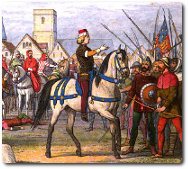The Wife of Bath's Prologue and Tale Contents
An era of social and economic change
Social & political unrest
 In the post-plague society, there were demands for higher wages. Estate-owners often had to agree to these demands in order to secure workers. However, the government attempted to peg wages at the pre-plague levels, through the 1351 Statute of Labourers. The statute caused resentment. It also seems to have had little effect.
In the post-plague society, there were demands for higher wages. Estate-owners often had to agree to these demands in order to secure workers. However, the government attempted to peg wages at the pre-plague levels, through the 1351 Statute of Labourers. The statute caused resentment. It also seems to have had little effect.
Another cause of resentment against the government was taxation. In particular, a series of ‘poll taxes' (poll means ‘head: these were taxes everyone had to pay) aroused especial anger and led to the English Rising of 1381 (also known as the Peasants' Revolt). There were uprisings in several areas, especially in the South-East and East Anglia. A march into London by men from Kent and Essex issued demands regarding:
- An end to the taxes
- The removal of ‘unfree' serf status
- A number of other reforms.
After enjoying some success initially, the Rising was crushed.
The power of the monarch
Medieval societies were not democracies. England was ruled by the king. At the same time, great lords wielded enormous power. Throughout Chaucer's life, English kings were engaged in a virtually continual struggle for power against the great landowners and nobles — dukes and earls. Richard II tried to centralise administration in certain respects, to bolster his own rule. One method of achieving this was to increase the administrative importance of gentry (knights, franklins, landowners) in the counties. This meant that the landowning upper-middle class (as opposed to the aristocratic lords) were becoming an increasingly prominent sector in English society, as were merchant elites in towns. This is reflected in The Canterbury Tales.
Challenges to the Church
The challenges which the Wife offers to the teaching of the Church reflected a more general questioning of all that it stood for.
Corruption
By the late middle ages, the Church had amassed enormous wealth. This all too often had the effect of turning it into a worldly organization. As a way of increasing its revenue, the Church seemed to tolerate abuses including superstition, false relics and the selling of indulgences.
John Wyclif
John Wyclif and his followers argued for a number of far-reaching reforms in the Church. Wycliffites called for the Church's wealth to be reallocated to the Crown. They also opposed many practices of the medieval Church, such as:
- Pilgrimages
- The honour given to saints, their shrines and their relics
- The celibate priesthood
- Religious houses for monks, nuns and friars.
Wyclif and his followers maintained that Christ and his followers had been poor and the Church should follow that example.
An English Bible
John Wyclif and his followers also produced the first close translation into English of the whole of the Latin Bible (known as the Vulgate). Previously there had been vernacular paraphrases that told many of the most important biblical narratives, but not in close, exact, translation. These paraphrases had been added to with:
- Legendary and apocryphal material
- Doctrine and interpretation, which lacked support from the Bible itself.
Wyclif's translation meant that ordinary people could read and understand the Bible for themselves, rather than rely on what they were told by the priest. This had the effect of destabilising traditional attitudes.
Recently Viewed
Scan and go

Scan on your mobile for direct link.